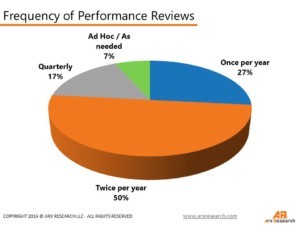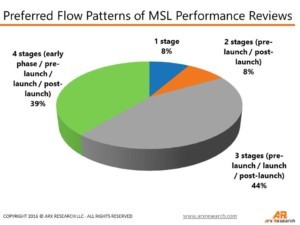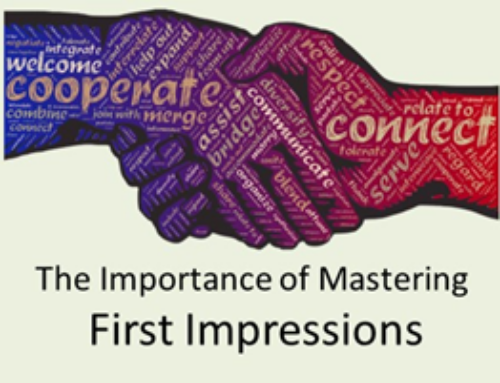A new research study MSL Performance Metrics: Valuing the Role Throughout a Product’s Lifecycle reveals key indicators on MSL performance reviews and identify the most common trends and perceptions among the medical affairs executives including how they see the 3 phases of MSL Performance Reviews. The full study presents an assessment of current practices, feedback from 37 executives across 26 organizations from 11 countries. The analysis provides executives with the various models of MSL performance reviews based on products’ lifecycles, as well as a first ever “consensus” model.
This article presents a few key findings from the full study: the frequency of the conduct of performance evaluations as well as how executives see main shifts when the MSL role adapts to its environment.
MSLs have held various responsibilities since the role’s inception and depends on companies’ needs, objectives and understanding of the function. Originally formed to interact with high level physicians, the position has evolved into a medical education role with a much wider audience, from third-party payers to Primary Care Providers and Key Opinion Leaders.
Many research organizations have studied performance evaluation in a superficial manner that produces very similar results year after year, a lack of discovery that leaves MSL management across the industry without recourse to improve the performance evaluation of their team members.
We find the issue mainly lies in the nature of the MSL function, a function that evolves with a product, from early phases to maturity. While MSL responsibilities remain fairly constant throughout, particular emphasis on one or more of these responsibilities depends upon where a product is in its lifecycle.
So then, how best can a company evaluate the MSL role? Should it follow one single path, with similar focus across time or should the evaluation follow distinct criteria based on the particular needs of a given phase in a product’s lifecycle? These are questions that the majority of MSL managers face year after year, with no real answers.
Frequency of Reviews
Sound performance evaluation programs prove crucial to ensuring that MSLs maintain an updated understanding of their role, their organization’s objectives and the fast-moving life science environment.
The performance evaluation practice has been part of companies’ processes for ages, but the MSL function has been tricky to nail down. As the graph below shows, companies use various frequencies to conduct MSL performance reviews.
Figure A: Frequency of Performance Reviews
Figure A shows that the majority (50%) of surveyed companies conduct MSL performance reviews twice per year, while 27% conduct this exercise once per year and 17% opted for a more intense pace of quarterly reviews. A handful of companies opt for an ad hoc approach, conducting reviews only when needed.
The 3 Phases of MSL Performance Reviews
Most companies encounter difficulties when measuring MSL teams’ performance because “hard” metrics do not provide accurate indications of how well MSLs are doing. Typical metrics such as number of interactions and number of thought leaders visited reflect MSLs activities but don’t necessarily depict the benefits KOL relationships provide the organization. Despite team managers’ best attempts to stay away from hard metrics, senior management still prefer collecting them to understand how the MSL groups are operating.
Figure B: Preferred Flow Patterns of MSLs’ Performance Reviews
Figure B shows study participants’ preferred patterns for evaluating the MSL function. It shows that almost half of executives see three distinct stages where a MSL’s activities will shift, therefore requiring different sets of evaluation. Another 39% of survey takers indicated that the MSL role shifts according to four stages, from early phase to post-launch.
Historically, most of the industry used the “one-stage” approach, now only considered by 8% of surveyed executives. Although this approach may work in some instances to evaluate how a MSL performs his work, this type of evaluation means applying the same importance to each evaluation factor throughout the career of a MSL and the products to which he or she is assigned.
Modifying the approach to evaluate a MSL in direct relation to a product lifecycle and adapting it to account for the intensity of each task and responsibility will be more representative of a MSL contribution to the organization. Arx Research dug into the mindset of executives to determine how best to address this issue.
Download a hardcopy PDF of this article: Arx Research Fact Sheet 5091 – MSL Performance Reviews
Get your copy of the full study here (click link):
MSL Performance Metrics: Valuing the Role Throughout a Product’s Lifecycle








